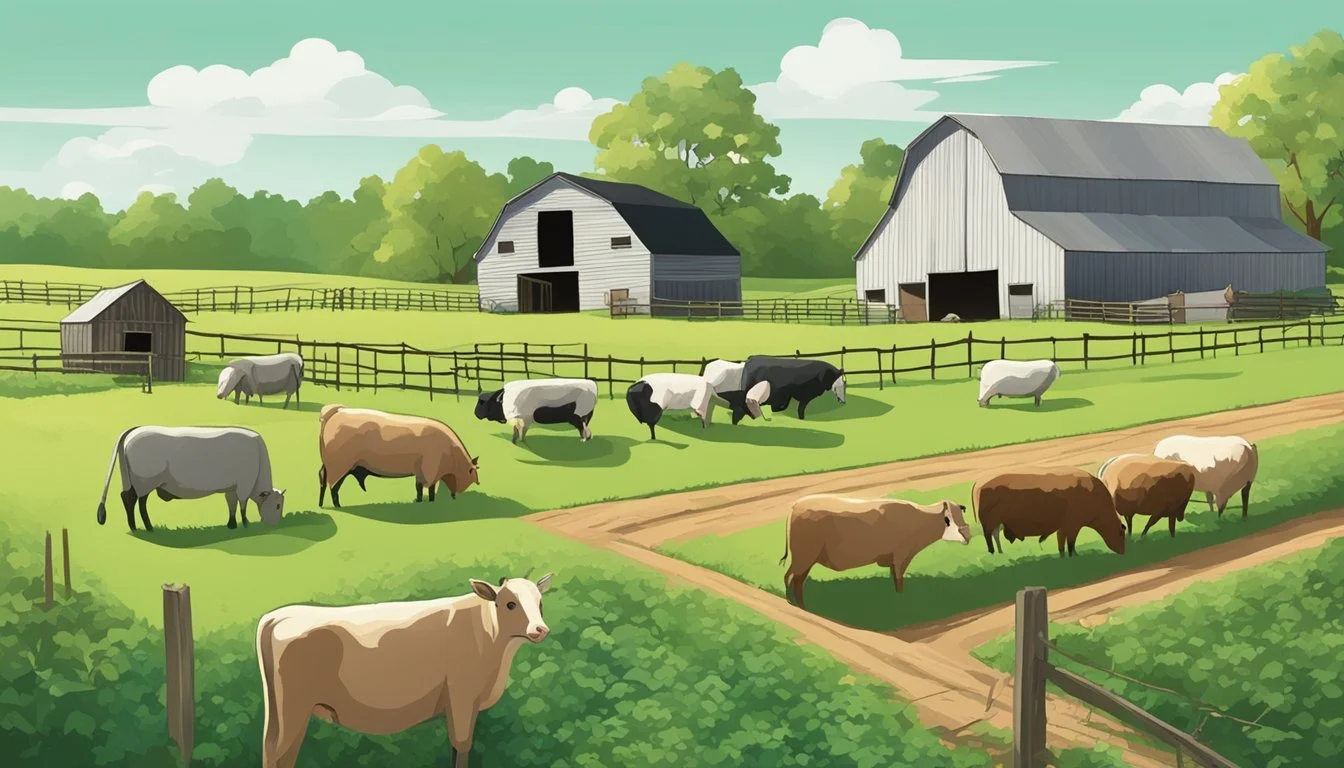Right to Farm Law in Arkansas
Understanding Agricultural Protections
The Right to Farm Law in Arkansas was established in 1981 with the intent to safeguard agricultural operations against nuisance lawsuits. As a state law, it underpins the significance of agriculture to Arkansas’s economy and way of life by limiting the conditions under which farming operations can be deemed a nuisance. This statutory protection acknowledges the inherent inconveniences associated with agricultural practices, allowing farmers to maintain their livelihood without the constant threat of legal battles over issues such as noise, odor, or dust.
Agricultural operations are a cornerstone of Arkansas's economic structure, and the Right to Farm Law is designed to preserve the viability of these operations. By offering statutory defenses to nuisance challenges, the law ensures that farmers employing practices commonly associated with agriculture are protected. The law's provisions, which have been updated through legislative sessions, including those in and up to 2021, specify the criteria under which agricultural activities are permitted to continue unhindered by neighboring land development or changes in land use.
However, since the law's enactment, Arkansas has experienced a notable reduction in the number of farm operations and the overall land dedicated to farming. This indicates complex dynamics between agricultural laws, market forces, and land use trends. The Right to Farm Law in Arkansas serves not only as a legal framework for current farmers but also reflects the evolving landscape of farm ownership and agricultural practices in the face of modern challenges.
Historical Context and Objectives of Right to Farm Laws
Right to Farm laws were enacted across the United States as a strategic response to protect agricultural operations from nuisance lawsuits, particularly as urbanization increased in the 1970s and 1980s. These laws provided statutory defenses for agricultural producers.
Evolution of Right to Farm Laws
Right to Farm laws have traditionally aimed to balance the interests of agricultural producers with those of their neighbors as residential development expanded into agriculturally zoned areas. They originated during an era marked by significant urban sprawl, where the influx of non-farming residents into traditionally agricultural regions began challenging the practices of existing farms. Arkansas, like many other states, codified these protections in 1981 to uphold the rights of farms against such nuisance claims.
Key Dates:
1970s: Heightened urban sprawl begins affecting pre-existing farms.
1981: Arkansas enacts Right to Farm Law.
Objectives and Rationales
The primary objective of Arkansas's Right to Farm law is to shield agricultural operations from nuisance lawsuits brought forth by newer residents who may not be accustomed to the realities of agricultural life. This legal mechanism serves to:
Protect: Legally supporting agricultural practice against intrusive claims.
Stabilize: Ensuring that farms can continue operations without the constant threat of litigation.
Sustain: Aiding in the preservation of agricultural land by making farming a more secure livelihood.
These goals reinforce the importance of agriculture to the state's economy and heritage, seeking to prevent the loss of agricultural resources due to non-agricultural urban pressures.
Right to Farm Law in Arkansas: Provisions and Coverage
The Right to Farm Law in Arkansas establishes a framework to protect agricultural operations by delineating the scope of protection, qualifying entities, and the range of activities considered typical to farming.
Scope of Protection
The law asserts a substantial level of protection for farming and agricultural operations, preemptively shielding them from certain nuisance lawsuits. It is particularly significant in scenarios where non-agrarian development encroaches upon historical agricultural land.
Qualifying Farming and Agricultural Operations
Qualifying operations under the Arkansas Right to Farm Law include those involving:
Cultivation of Crops: The production of plant-based commodities.
Livestock Rearing: This encompasses the breeding, raising, and caring for animals with agricultural utility.
Silviculture: The care and cultivation of forest trees is recognized as a protected agricultural activity.
Aquaculture: The breeding, rearing, and harvesting of aquatic animals and plants in a controlled environment.
Protected Activities
Protected activities under this legislation are those commonly associated with agriculture, such as:
Use of Agricultural Practices: Such as tilling, planting, harvesting, and application of pesticides and fertilizers.
Noise Production: This can include sounds typically emanating from farm equipment and livestock.
Odor Emissions: Naturally occurring smells resulting from the management and processing of crops and animals.
Light Exposure: Lighting essential for the growth and security of agricultural operations.
The law advocates for the sustained viability of farmland by providing a legal defense framework, ensuring that agriculture remains a robust part of Arkansas' economic and cultural heritage.
Legal Challenges and Nuisance Actions
Arkansas' Right-to-Farm Law provides a framework for understanding the balance between agricultural practices and the rights of neighboring landowners. This section explores how the law shapes defenses against nuisance lawsuits, details significant legal cases and precedents, and discusses the constitutionality issues that have arisen in the application of the law.
Defense Against Nuisance Lawsuits
Arkansas' Right-to-Farm Law provisions serve as a statutory defense for agricultural producers against nuisance lawsuits. These defenses play a crucial role in safeguarding farmers from claims that might arise from the lawful operations of their agricultural activities. Specifically, the Ark. Code Ann. § 2-4-101 delineates the circumstances under which nuisance actions may not be deemed applicable.
Notable aspects include:
Statutory Defense: Farmers can cite the Right-to-Farm Law as a defense in civil actions where farm operations are accused of being a nuisance.
Timeframe: The agricultural operation must be in existence for more than one year to qualify for these statutory protections.
Notable Cases and Precedents
Over the years, Arkansas courts have been faced with multiple nuisance suits involving agricultural operations, which have helped to establish key precedents in interpreting the Right-to-Farm Law. Notable cases can illustrate the application of the law and how it serves to resolve conflicts between farming activities and neighboring landowners' complaints.
An example of a relevant case could be where a long-standing farm operation is faced with newbie suburban neighbors filing nuisance claims because of regular farm activities like early morning tractor noises or fertilization odors. In such cases, the Right-to-Farm defenses become pivotal.
Constitutionality Issues
The constitutionality of Right-to-Farm laws, including Arkansas', often comes under scrutiny, particularly in relation to the takings clause and the balance between private property rights and governmental regulation. Courts have been tasked to ensure that the application of these laws does not infringe upon constitutional rights, while also considering the state's interest in preserving and protecting its agricultural resources.
Key constitutional questions include:
Takings Clause: The extent to which Right-to-Farm laws constitute a 'taking' of private property without just compensation.
Due Process: Whether the provisions of the Right-to-Farm laws meet the requirements of procedural and substantive due process.
In this light, while nuisance actions form a significant part of the legal landscape for farmers, the Right-to-Farm Law in Arkansas is designed to offer a measure of legal protection from undue interference, provided these defenses are constitutionally sound.
Impact of Right to Farm Laws on Farming Practices
Right to Farm laws significantly shape the operational landscape for Arkansas agriculture, defining how farming practices evolve and their interplay with the surrounding legal and environmental frameworks.
Influence on Agricultural Technology and Methods
Right to Farm laws in Arkansas offer protection to farmers seeking to adopt new technologies and methods, fostering an environment where innovation can thrive. Farmers are more likely to invest in modern equipment and practices knowing that their right to farm is statutorily defended. This legislative support aids them in meeting compliance standards and boosting production efficiency.
Consequences for Small and Family Farmers
For small and family farmers, Right to Farm statutes are double-edged. On one side, they provide a shield against nuisance lawsuits, which can be particularly burdensome for operations with limited resources. On the other, there's a concern that these laws disproportionately favor larger agricultural operations that can more readily absorb the costs of litigation and compliance.
Compatibility with Environmental Regulations
The interrelation between Right to Farm laws and environmental regulations is complex. While these laws solidify the position of agriculture in Arkansas, they raise questions about compliance with environmental standards. Assurances given to farmers can sometimes be seen as at odds with the enforcement of regulations intended to protect the environment and public health.
Integration with Other State and Federal Regulations
Arkansas' Right-to-Farm Law operates within a complex web of other state and federal regulations that impact agricultural practices and policies.
Interaction with Federal Agricultural Policies
Federal laws set nationwide standards and practices for agriculture, which are often implemented by agencies like the United States Department of Agriculture (USDA). An example is the Clean Water Act, which affects farming operations by imposing regulations on water pollution. These federal regulations can override state laws if conflicts arise. However, Arkansas' Right-to-Farm Law typically harmonizes with federal policies by providing additional protections for farmers at the state level against nuisance lawsuits, which are not typically addressed in federal statutes.
State Variations and Statutory Schemes
While all fifty states have enacted right-to-farm laws, each presents a unique statutory scheme tailored to the state's individual needs and agricultural profile. The National AgLaw Center highlights that these statutes vary significantly from state to state, reflecting local legislative priorities. For example, nuances in Arkansas' statute might provide different levels of protection compared to neighboring states. It's critical for interstate agricultural businesses to understand these state-by-state differences to ensure compliance with local laws. The Right-to-Farm Law in Arkansas interacts with other state regulations, potentially including zoning laws and environmental statutes, to create a comprehensive legal framework for agricultural operations within the state.
Resource and Educational Support for Farmers
Arkansas provides a comprehensive network of resources geared towards the education and support of its farmers. These resources come in the form of information centers and legal guidance as well as research publications that aid in the advancement of agricultural practices.
Information Centers and Legal Assistance
Arkansas's farmers have access to a variety of information centers where they can receive free classes, training, and research-based advice. One key resource is the University of Arkansas Division of Agriculture, which operates offices in all 75 counties. County Extension Agents are pivotal resources, offering support on topics ranging from gardening to business development. For legal assistance, resources such as the Arkansas's Right-to-Farm law provide frameworks and defense strategies for agricultural operations against nuisance claims.
Key Programs:
Business Development
Health and Fitness
4-H Programs
Available Tools:
Extension Publications
Legal Framework Assistance
Research and Publications
The state's commitment to research and innovation in agriculture is evident through its various publications and the work of centers like the Center for Arkansas Farms and Food (CAFF). CAFF's Farm School combines traditional and experiential learning opportunities, focusing on strengthening food and farming systems. Apart from learning, farmers are supported through publications detailing the nuances of the Right-to-Farm laws and research on sustainable agricultural practices.
Types of Publications:
Arkansas's Right-to-Farm Law Overview
Research Papers on Agricultural Best Practices
Research Publication Topics:
Agricultural Resource Conservation
Sustainable Farming Methods
Future Trends and Ongoing Debates
In Arkansas, the Right to Farm Law continues to shape agricultural policy, impacting rural areas, trade practices, and the dynamic with urbanization.
Role in Supporting Sustainable Agriculture
The Right to Farm Law in Arkansas plays a crucial role in safeguarding agricultural practices that contribute significantly to the state's economy. It ensures that farms can operate without the undue burden of nuisance lawsuits, which is essential for the longevity and sustainability of farming enterprises. Notably, these protections also encourage farms to invest in and adopt sustainable practices that can lead to enhanced environmental stewardship and potentially improved trade benefits.
Sustainable Methods: Farmers have more security to implement resource-conserving techniques.
Trade Implications: Sustainable practices can foster favorable trade terms and market access.
Balancing Interests: Agriculture vs. Urbanization
As urbanization intensifies, Arkansas faces the challenge of balancing agricultural interests with the demands of growing urban areas. The Right to Farm Law provides a legal framework that helps:
Protect rural characteristics: It maintains the viability of farming in rural regions amidst expanding urban development.
Mitigate urban encroachment: The law serves to shield farmlands from the pressures of urban sprawl and potential conflicts with new developments.
However, this balance is an ongoing debate as both sectors evolve and as state lawmakers and stakeholders continuously examine and adjust the legal protections afforded by the Right to Farm Law to reflect the changing needs of Arkansas's populous and economy.
Comparative Analysis with Other States
Arkansas's Right to Farm Law shares foundational goals with those in other states, aimed at protecting agricultural operations. However, its effectiveness and the nuances in its language can be understood by comparing it with similar laws in states like Florida, South Carolina, and Texas.
Case Studies: Florida, South Carolina, and Texas
Florida: Florida's Right to Farm Act provides robust protections for farm operations by limiting nuisance lawsuits. These protections are afforded assuming farms comply with state and federal environmental regulations. Florida emphasizes protection against changes in land use in the surrounding areas, safeguarding farmers if non-agricultural land developments encroach upon their operations.
South Carolina: In South Carolina, the "Nuisance Suits" law protects farms from nuisance complaints if the farm was not negligent and had been operational before the complaining party took possession of the nearby land. South Carolina focuses on the "coming to the nuisance" defense—a legal principle that protects longstanding agricultural operations from nuisance claims brought by new neighbors.
Texas: Texas's Right to Farm statute is particularly strong. It protects agricultural operations by requiring claimants to prove that farm operations are both unlawful and negligent to succeed in a nuisance claim. Texas law offers a two-year limitation period for bringing a nuisance lawsuit against farms, which is more generous than the one-year limitation period in Arkansas.
Key Differences in Legislative Approaches
Arkansas's Right to Farm Law includes protection mechanisms such as defining what constitutes an "agricultural operation" and instituting a one-year limitations period for bringing forward claims. This contrasts with Texas’s two-year period, which provides a longer duration for operators to be immune from nuisance suits.
Legislative approaches also differ in terms of how they support the agricultural sector against urban encroachment. For example, Florida has taken explicit steps to safeguard agricultural lands against the pressures of urban development. Conversely, statutes in Arkansas and South Carolina provide defense strategies for farms by leveraging principles like the "coming to the nuisance" clause.
In summary, Arkansas shares the overarching aim of protecting agricultural interests with Florida, South Carolina, and Texas, yet differences in statutory provisions and legal intricacies highlight the state-specific nature of Right to Farm laws.
Conclusion
Arkansas' Right-to-Farm Law is designed to safeguard agricultural operations by offering defenses against nuisance lawsuits. Initially passed in 1981, the law reflects a commitment to protecting the state's farming interests and has been a statutory staple for over four decades.
Farmers in Arkansas, to be considered qualifying farmers, must meet the definition set forth by the USDA, which involves generating at least $1,000 in agricultural products yearly. These farmers benefit from the law's provisions, which establish essential defenses to support the agribusiness sector.
The scope of the Right-to-Farm Law covers different agricultural practices, limiting the conditions under which farms can be deemed a nuisance. It recognizes that normal agricultural operations should not be penalized for functioning within the accepted standards. Statutory schemes like the "Coming to the Nuisance" defense protect existing farms from new neighbors who may file complaints.
Researchers analyzing the impact of the law have noted the decline in the number of farm operations since its enactment. However, this decline could be attributed to multiple variables and not solely to the Right-to-Farm Law.
As of the last update, Arkansas' agricultural resources remain essential to the country, and the state's food law system continues to evolve. It is imperative to scrutinize the specific details of such laws to ensure that they serve the intended purpose of supporting agricultural stability and growth.











